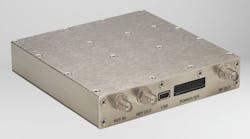Frequency synthesizers—along with many other RF/microwave test-and-measurement functions—have been undergoing a metamorphosis of sorts, transforming from large and expensive benchtop instruments into smaller, modular units that require external power supplies and controls. The model FSL-0010 from Phase Matrix is one such “next-generation” frequency synthesizer, offering full-sized performance from 650 MHz to 10 GHz in a housing measuring just 4.0 x 4.0 x 0.8 in. The small housing doesn’t shrink the electrical performance of this unit, however, which can hold its own against much-larger, more-expensive frequency synthesizers.
The FSL-0010 (see figure) is the latest addition to the QuickSyn® line of modular frequency synthesizers from Phase Matrix, although it is less than one-half the size of the company’s earlier 10- and 20-GHz frequency synthesizers. The tiny FSL-0010 includesUniversal-Serial-Bus (USB) and serial-peripheral-interface (SPI) connectors for control with a personal computer (PC) and requires only connection to a power supply and a PC for operation. A soft front panel appearing on the PC allows a user access to different operating modes, such as list mode and frequency sweep mode. The diminutive frequency synthesizer tunes with 0.001-Hz frequency resolution across its frequency range, with frequency stability matching that of its (internal or external) frequency reference source. It boasts 100-μs frequency switching speed using triggered list mode (it can select from as many as 32,000 points in list mode) and 200-μs frequency switching speed under the control of individual SPI commands.
Although the FSL-0010 is a fraction of the size of traditional bench-top, instrument-grade frequency synthesizers, it packs the essential performance needed for high-quality test-signal generation into its compact housing. Typical harmonic levels are -12 dBc for output signal levels at a minimum of +15 dBm and typically at +18 dBm. Nonharmonic spurious signal levels reach a maximum of -60 dBc and are typically at -70 dBc. The output return loss is typically -10 dB.
Phase noise is impressive for the FSL-0010, across its full bandwidth and whether measured close to or from far the carrier. The phase noise is typically -126 dBc/Hz offset 1 kHz from a 0.65-GHz carrier and typically -104 dBc/Hz offset 1 kHz from a 10-GHz carrier. The phase noise drops to -138 dBc/Hz offset 10 kHz from a 0.65-GHz carrier and typically -117 dBc/Hz offset 10 kHz from a 10-GHz carrier. The FSL-0010 synthesizer maintains that low phase noise further from the carrier, with phase noise of -138 dBc/Hz offset 100 kHz from a 0.65-GHz carrier and typically -117 dBc/Hz offset 100 kHz from a 10-GHz carrier.
The FSL-0010 is equipped with an internal 10-MHz frequency reference which provides a nominal output level of +5 dBm (flat within ±2 dB) for operation with the synthesizer’s circuitry. This reference oscillator maintains frequency stability of ±1 ppm across the operating temperature range of the synthesizer, with an aging rate of ±1 ppm/year. The synthesizer has a locking range of ±5 ppm with the reference oscillator. The FSL-0010 can also operate with an external 10-MHz frequency reference oscillator capable of +5-dBm output power.
The FSL-0010 frequency synthesizer operates from a +12-VDC supply with nominal power consumption of only 11 W. The warm-up time for the signal source is only one minute. The FSL-0010 is equipped with SMA female connectors for reference input and output ports and RF output port.
Phase Matrix, Inc., 4600 Patrick Henry Dr., Santa Clara, CA 95054; (408) 610-6810.
